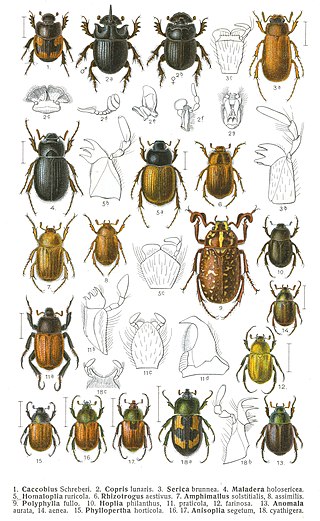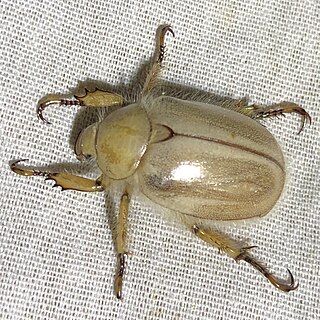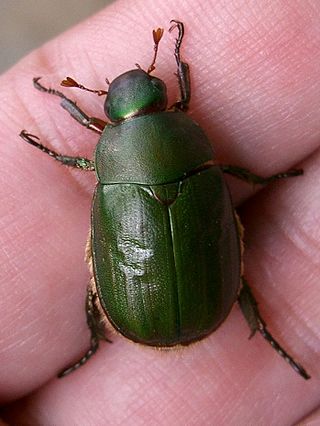
The family Scarabaeidae, as currently defined, consists of over 35,000 species of beetles worldwide; they are often called scarabs or scarab beetles. The classification of this family has undergone significant change in recent years. Several subfamilies have been elevated to family rank, and some reduced to lower ranks. The subfamilies listed in this article are in accordance with those in Catalog of Life (2023).

Anomala is a genus of shining leaf chafers in the family of beetles known as Scarabaeidae. There are at least 1,200 described species in Anomala.

Anomala binotata is a species of shining leaf chafer in the family of scarab beetles, Scarabaeidae. The common name "Shining leaf chafer" is sometimes applied to this species specifically, but is more often used to describe all members of the subfamily Rutelinae.
Shining leaf chafer may refer to:

Cyclocephala is a genus of scarab beetles from the subfamily Dynastinae. Beetles of this genus occur from southeastern Canada to Argentina, India and the West Indies.

Argyripa is a genus of flower chafer belonging to the family Scarabaeidae.
Rutela formosa, the handsome flower scarab, is a species of shining leaf chafer in the family of beetles known as Scarabaeidae.

Pseudocotalpa sonorica is a species of shining leaf chafer in the family of beetles known as Scarabaeidae. It is endemic to the Algodones Dunes in North America.

Chrysina lecontei, or Leconte's chrysina, is a species of shining leaf chafer in the family of beetles known as Scarabaeidae. It is found in southern United States and northern Mexico.
Anomala flavipennis, the panhandle beach anomala scarab beetle, is a species of shining leaf chafer in the family Scarabaeidae.
Pseudocotalpa andrewsi, known generally as the Andrews dune scarab beetle or Andrews dune beetle, is a species of shining leaf chafer in the family Scarabaeidae. It is endemic to the Algodones Dunes in California.
Pelidnota lugubris is a species of shining leaf chafer in the family of beetles known as Scarabaeidae.
Anomala tibialis, known generally as the tibial scarab or padre island tibial scarab, is a species of shining leaf chafer in the family of beetles known as Scarabaeidae.

Chrysina beyeri, or Beyer's scarab, is a species of shining leaf chafer in the family of beetles known as Scarabaeidae. This bright green beetle is native to Chihuahua in Mexico and southeastern Arizona in the United States. It resembles C. woodi in both size and general appearance, but that species has green legs and blue tarsi.
Parastasia brevipes is a species of shining leaf chafer in the family of beetles known as Scarabaeidae.
Cotalpa conclamara, the Texas goldsmith beetle, is a species of shining leaf chafer in the family Scarabaeidae.

Chrysina woodi, or Wood's jewel scarab, is a species of shining leaf chafer in the family of beetles known as Scarabaeidae. This bright green beetle is native to Chihuahua in Mexico, and New Mexico and Texas in the United States. This beetle is 25–35 mm (1.0–1.4 in) long and it resembles C. beyeri, but that species has all blue-purple legs and tarsi.

Anomala albopilosa, known by the common names green chafer, white-haired leaf chafer and sugarcane white grub, is a species of chafer beetle in the family Scarabaeidae. It was originally described in the genus Euchlora by Frederick William Hope in 1839. The beetle is native to the four major islands of Japan, the Ryukyu Islands, Korea, and Taiwan.
Anomala sulcatula, commonly known as the Philippine chafer, is a species of shining leaf chafers in the genus Anomala. It is considered as a pest as its larvae feed on sugarcane, rice, corn and maize.

Anomala cuprea, also known by its common name cupreous chafer, is a species from the genus Anomala.











